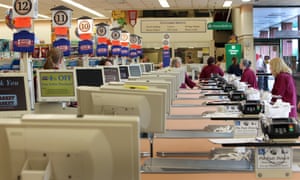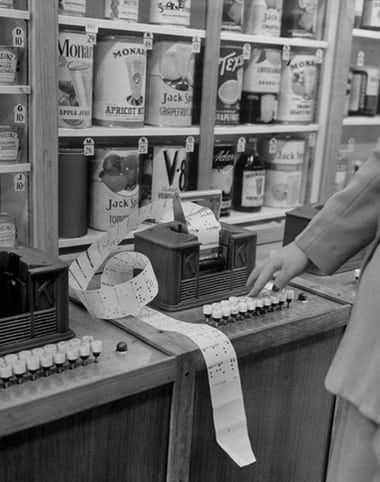The Keedoozle automatic grocery store, with a customer using the key to select products she wishes to purchase. Photograph: Francis Miller/The Life Picture Collection/Getty Images
Donald Trump is fixated on a vision of masculine, blue-collar employment. But the retail sector has long had a far greater impact on American employment – and checkout-line technology is putting it at risk
he day before a fully automated grocery store opened its doors in 1939, the inventor Clarence Saunders took out a full page advertisement in the Memphis Press-Scimitar warning “old duds” with “cobwebby brains” to keep away. The Keedoozle, with its glass cases of merchandise and high-tech system of circuitry and conveyer belts, was cutting edge for the era and only those “of spirit, of understanding” should dare enter.
Inside the gleaming Tennessee store, shoppers inserted a key into a slot below their chosen items, producing a ticker tape list that, when fed into a machine, sent the goods traveling down a conveyer belt and into the hands of the customer. “People could just get what they want – boom, it comes out – and move on,” recalled Jim Riot, 75, who visited the store as a child. “It felt like it was The Jetsons.”
Despite Saunders’s best efforts, the Keedoozle’s circuits frequently failed and the store closed for good by 1949.
But 72 years after he attempted to patent his idea, advances in robotics, artificial intelligence, and other technologies are making the dream of a worker-free store a reality. AndAmerican cashiers may soon be checking out.
A recent analysis by Cornerstone Capital Group suggests that 7.5m retail jobs – the most common type of job in the country – are at “high risk of computerization”, with the 3.5m cashiers likely to be particularly hard hit.
Another report, by McKinsey, suggests that a new generation of high tech grocery stores that automatically charge customers for the goods they take – no check-out required – and use robots for inventory and stocking could reduce the number of labor hours needed by nearly two-thirds. It all translates into millions of Americans’ jobs under threat.
Alfredo Duran, a 37-year-old New Yorker, has been staring down that threat. He began his retail career at the Gap, taking part in that quintessential American rite of passage: getting a summer job in high school. Twenty-one years later – after a career that took him from fast fashion chains to department stores to high-end boutiques and saw him climb the ladder from cashier to visual merchandiser to store manager – he’s looking for a way out.
“Retail used to be a career,” Duran said. “You actually sat with your store manager and told them, ‘This is where I see myself in five years.’ No one thinks like that anymore. It’s just a warm body who can pick up the clothes that were thrown on the floor.”
Duran takes pride in the level of the customer service he provides shoppers, but he’s not convinced that his skills will be sought after in the stores of the future, so he’s exploring going to work in the hotel industry. “It may be good for people that are going into technology,” he said of the onset of automation, “but what about people like myself who are not very technical?”
For all Donald Trump’s talk about the raw deal that has been visited on American workers, he rarely mentions people like Duran.

The public debate about jobs in the US has been dominated by Trump’s fixation with a particular vision of masculine, blue collar employment: a white man in a hard hat, mining coal in Appalachia or clocking hours on an assembly line in the industrial midwest. But for years, the employment impact of those industries has been dwarfed by the retail sector, which surpassed manufacturing’s total employment in 2002 and now accounts for about 10% of the entire working population, or 16 million people.
“Coal miners have gotten a lot of attention, but dislocation of retail is just getting started. It’s not localized; it’s ubiquitous,” said Mark Cohen, director of retail studies at Columbia Business School. “This is a crisis that doesn’t have any solutions at the moment and that is yet to run its course.”
The suburban shopping malls that hollowed out main streets in the 1970s and 80s have increasingly become hollow shells themselves, and more closures are expected. Headlines about America’s most recognized brands – Sears, Macy’s, RadioShack, Payless Shoes – have been dominated by store closings and bankruptcies. Credit Suisse has projected that 8,640 stores will close in 2017, easily surpassing the rate of closures during the great recession.
The fallout from the impending crisis will likely be felt most by a different population from Trump’s fetishized ideal of the white, male worker. According to the Cornerstone report, 73% of cashiers are women. And an analysis of retail workers by Demos found that black people and Latinos are overrepresented in the cashier positions, which are the lowest paid.
Seattle offers a glimpse of the store of the future. Amazon’s experimental convenience store in the city has eliminated the entire checkout process – erasing the need for cashiers. Customers at Amazon Go just grab what they want and walk out, with charges automatically sent to their Amazon Prime accounts.

The store, which is currently only open to Amazon employees, seems to have been designed with a defense of its job-killing potential in mind. Rather than using the store windows to show off merchandise, Amazon has put the employees that do work there – as sales associates and cooks – on display. Imagine Macy’s Christmas window decorations – but instead of seeing a magical winter wonderland, passersby look into an employee break area, with its industrial furniture and government-mandated notices.
The message seems clear: don’t worry, people are still employed here.
But whatever comfort may come from watching a real live human being spread mustard on a sandwich or recline on a sofa has not prevented Amazon from being tagged as all four horsemen of the retail jobs apocalypse.
A spokesperson for Amazon said in a statement that the company had “no plans” to use its Amazon Go technology to get rid of cashiers at the 465 Whole Foods stores it just acquired. But the Cornerstone analysis noted that airlines and banks made similar assurances about job losses when they introduced check-in kiosks and ATMs respectively; in both industries, employment and wages have declined.
Cohen pointed to another historical analogy: telephone companies, which once employed armies of workers to service landlines across the country, saw employment numbers crash with the advent of wireless telecommunications.
The job loss projections have left many retail workers and the union that represents them apprehensive. While Chelsea Connor, spokeswoman for the Retail, Wholesale, and Department Store Union (RWDSU), talked optimistically of the “massive boom in jobs in fulfillment and distribution” created by e-commerce, Cohen warned that those jobs were at risk of automation as well.
“It’s not going to be very much longer in the future that robots are able to pick individual orders for customers,” he said. Indeed, Amazon runs an annual robotics competition aimed at achieving that very goal.
Caleb Kulick, a cashier at a Shopko in Plover, Wisconsin, has accepted the automation of his job.
“There’s no way to stop it,” he said. “A Target in my town just switched over to self-checkouts, and suddenly a job which used to require four employees now only requires one.”
“My real concern is what is going to replace those jobs, and so far there are no good answers … No politician that I’ve heard of has any answers to these problems.”
Marc Perronne, the president of the United Food and Commercial Workers union which represents 1.3m retail, grocery and food processing workers, said that the organization was working on helping its members go back to school to get high school equivalencies or associate’s degrees, with an eye on technological job displacement.
“People generally look at technology as a good thing, and I look at technology as a good thing, but when it comes to a point that many people are going to be put on the street … I think as a society we have to start talking about it,” Perrone said. “Our organization has decided that we’re going to try to provide as much educational opportunity as we can to give them the tools for whatever comes next.”
Still, not everyone is persuaded that the future will be as jobless as feared.
Brendan Witcher, an e-commerce analyst with Forrester, argued that the checkout-free store remains “a long way off”. In December, Amazon said that Amazon Go would open to the public in “early 2017” – a self-imposed deadline that the store has missed.
“It is an exciting concept. It was also an exciting concept when IBM introduced it in 2006,” Witcher said, referring to a decade-old advertisement by IBM portraying a similar grab-and-go shopping experience.
Witcher said successful retailers would incorporate technologies that improve customer experiences rather than simply eliminate jobs.

But stores that simply transfer labor from employees to customers, like those that install the much-maligned self-checkout lanes, he said, are “really missing the point … Smart retailers are using digital to make their associates better at their jobs, not eliminate their jobs.”
Witcher praised retailers in China who allow customers to use WeChat, a messaging app, to scan the items they want, show their phones and purchases to a retail associate, and then walk out the door. The process eliminates checkout lines, but keeps a human involved to prevent theft, all while freeing up employees to spend more time assisting customers.
It’s those customer-oriented tasks that Alexis Lambertis, an organizer with RWDSU, argues will forestall too many job losses in retail. Lambertis worked for two years at New York City’s Babeland, a sex toy boutique. Babeland is exactly the kind of brick-and-mortar shop that would seem imperiled by the privacy of online shopping. But Lambertis said she frequently served customers who had ordered sex toys online, only to be disappointed.
“They are coming in because they want someone’s input … They are looking to us as sources of knowledge and information,” she said. “At the end of the day, you will always have people who are going to need help from a human. I’ve seen that everywhere.
“I’ve seen that in sex toy stores, where people will pick things up and have no idea how it works,” she said. “And the same thing goes for window blinds.”

